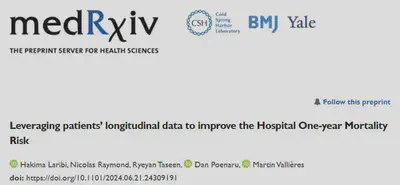Article : Leveraging patients’ longitudinal data to improve the Hospital One-year Mortality Risk

Date
2024-07-26
Auteurs
- Hakima Laribi1
- Nicolas Raymond1
- Ryeyan Taseen2
- Dan Poenaru3,4
- Martin Vallières1,5
1 Department of Computer Science, Université de Sherbrooke, Sherbrooke, QC, Canada
2 Department of Medicine, Cambridge Memorial Hospital, Cambridge, Canada.
3 Department of Pediatric Surgery, McGill University Health Centre, Montreal, Canada.
4 Centre for Outcomes Research and Evaluation (CORE), Research Institute of the McGill University Health Centre, Montreal, Canada.
5 Centre de recherche du Centre hospitalier universitaire de Sherbrooke, Sherbrooke, Canada.
Résumé
Purpose: Predicting medium-term survival after admission is necessary for identifying end-of-life patients who may benefit from goals of care (GOC) discussions. Considering that several patients have multiple hospital admissions, this study leverages patients’ longitudinal data and information collected routinely at admission to predict the Hospital One-year Mortality Risk.
Methods: We propose an Ensemble Long Short-term Memory neural network (ELSTM) to predict one-year mortality using patients’ longitudinal records. The model was evaluated: (i) with only predictors reported upon admission (AdmDemo); and (ii) also with diagnoses available later during patients’ stay (AdmDemoDx). Using records of 123,646 patients with 250,812 hospitalizations from 2011-2021, our dataset was split into a learning set (2011-2017) to compare models with and without longitudinal information using nested cross-validation, and a holdout set (2017-2021) to assess clinical utility towards GOC discussions.
Results: The ELSTM achieved a significant increase in predictive performance using longitudinal information (p-value < 0.05) for both the AdmDemo and AdmDemoDx predictors. For randomly selected hospitalizations in the holdout set, the ELSTM showed: (i) AUROCs of 0.83 (AdmDemo) and 0.87 (AdmDemoDx); and (ii) superior decision-making properties, notably with an increase in precision from 0.25 for the standard process to 0.28 (AdmDemo) and 0.36 (AdmDemoDx). Feature importance analysis confirmed that the utility of the longitudinal information increases with the number of patient hospitalizations.
Conclusion: Integrating patients’ longitudinal data provides better insights into the severity of illness and the overall patient condition, in particular when limited information is available during their stay.